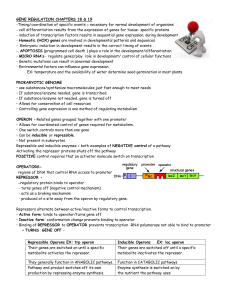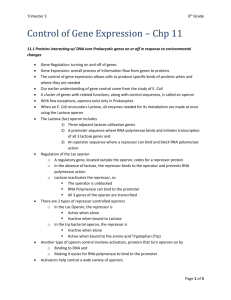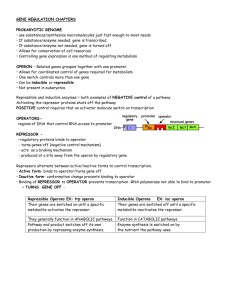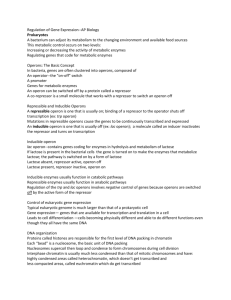Chapter 18 PPT - Regulation of Gene Expression
advertisement
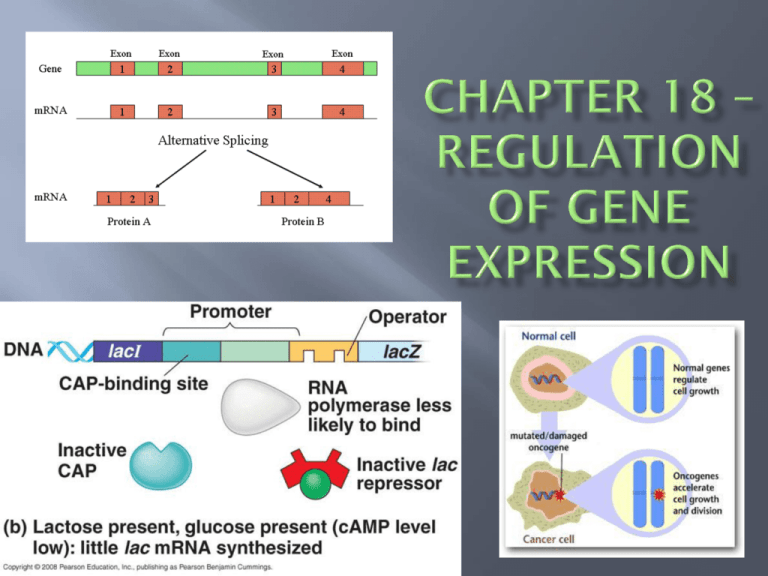
Both prokaryotes and eukaryotes alter their patterns of gene expression in response to changes in environmental conditions. During development, gene expression must be carefully regulated to ensure that the right genes are expressed only at the correct time and in the correct place. - Bacteria often respond to environmental change by regulating at the level of TRANSCRIPTION!! - Natural selection favors bacteria that express only those genes whose products are needed by the cell. - Metabolic control occurs on two levels. - First, cells can adjust the ACTIVITY of enzymes already present. This may happen by feedback inhibition, in which the activity of the first enzyme in a pathway is inhibited by the pathway’s end product. - Second, cells can vary the NUMBER of specific ENZYME MOLECULES they make by regulating gene expression. The basic mechanism for the control of gene expression in bacteria, known as the operon model, was described by Francois Jacob and Jacques Monod in 1961. Using these operons to alter patterns of gene expression in prokaryotes serves an organism’s survival by allowing an organism to adjust to changes in the environmental conditions. Operons are how prokaryotic genes are controlled. Francois Jacob A key advantage of grouping genes with related functions into one transcription unit is that a single on-off switch can control a cluster of functionally related genes. TRP Operon = makes tryptophan LAC Operon = breaks down lactose Jacques Monod Prokaryotic cells can control metabolism two ways: 1. Regulate expression of genes (vary number of enzymes made) 2. Adjust the activity of the enzymes already present (activators/ inhibitors) PROMOTER = place where the RNA polymerase binds; includes a TATA box OPERATOR = ON/ OFF Switch (located within the promoter); allows or disallows RNA polymerase to bind REPRESSOR = this binds to the operator to block the attachment of RNA Polymerase when it is in the active form They are made up of 3 parts: 1. Genes it controls (called structural genes) 2. Promoters 3. Operator (on/ off switch) Recall: Transcription Factors bind to the promoter or TATA box to help RNA Polymerase bind The repressor is coded for by a regulatory gene that is located away from the operon. It has its own promoter. For the trp operon, the repressor is made in the inactive form, and needs tryptophan to become active. SO, the gene is usually ON, unless the repressor gets turned into the active form. Repressible operons are always ON unless repressed (switched off) Therefore, the OPERON is usually OFF (unless switched on) All the genes are found together, so that ONE operator controls expression of ALL of the genes Bacteria synthesize tryptophan from a pathway that includes 5 enzymes. These enzymes are coded for by 5 genes all found together in the Trp Operon. Feedback Inhibition – if much tryptophan is present, it acts as a co-repressor. It binds to the repressor, and activates it. Then, the repressor binds to the operator and blocks the attachment of RNA polymerase Co-repressor (ex. Tryptophan) turns genes OFF by activating the repressor If tryptophan is present, the repressor is “active”, so it binds to the promoter blocking the RNA polymerase. Therefore, the production of tryptophan is stopped because there is already enough in the environment. SO…PRESENCE OF TRYPTOPHAN TURNS THE REPRESSOR ON, WHICH TURNS THE OPERON OFF ENOUGH TRYPTOPHAN IS PRESENT SO WE DON’T NEED TO MAKE ANY MORE! SO…. No tryptophan = repressor inactive = operon ON = making tryptophan Lots of tryptophan = repressor activated by corepressor = operon OFF = no tryptophan made Tryptophan Operon – On vs. Off Inducible Operons are always OFF unless switched ON. So the repressor is normally ACTIVE, it is normally repressing the operon (the regulatory gene that encodes the repressor encodes the active conformation). It is bound to the operator, and therefore blocks RNA polymerase. The Lac Operon breaks down lactose. If its not present in the bacteria's environment, there is no need to break it down. Once it becomes available, the operon would have to get switched on to break it down. The repressor in the Lac Operon is made in the active form, so it is normally switched ON. If lactose is present, an isomer of it, allolactose, acts as an inducer. It binds to the repressor, which inactivates it. Now that the repressor no longer works, the operon can turn on. Nothing is bound to the operator, so RNA polymerase can bind, and the lactose can be broken down. An inducer inactivates the repressor Remember, these operons code for the mRNA that is going to go to the ribosomes to make the enzymes that will either break down lactose, or make tryptophan. Inducible Operons → 1. Repressors made in ACTIVE form 2. Operon is usually OFF 3. When the repressor is inactivated by a molecule, then the operon can be switched ON 4. Ex. Lac Operon → Lactose metabolism Repressible Operons → 1. Repressors made in the INACTIVE form 2. Operon is usually ON 3. When the repressor is switched on, it binds to the operator and blocks RNA Polymerase , which switches the operon OFF 4. Ex. Trp Operon → Synthesizing tryptophan Both of these are examples of NEGATIVE control – the operon is switched OFF by an active repressor. Positive Control = something that binds to the operon directly that switches it ON; the degree of transcription depends on the concentration of other substances cAMP = cyclic AMP; accumulates when glucose (E source) drops CAP = Catabolite Activator Protein; activates transcription initiation of operons SO…Glucose drops = cAMP increases = CAP becomes active = transcription is ON Lactose (allolactose) present → Operon turned ON NO LACTOSE (allolactose) → Operon turned OFF Lactose present → ON Glucose present (LOW cAMP) → CAP inactive , on a LITTLE Lactose present → ON No Glucose (HIGH cAMP) → CAP active, on a LOT Negative Control → Repressor (presence/ absense allolactose) = ON/ OFF SWITCH Positive Control → CAP (level of transcription); level of glucose and thus cAMP = VOLUME CONTROL In PROKARYOTES, they regulate gene expression at the level of TRANSCRIPTION In EUKARYOTES (greater complexity), they have the opportunity to regulate at many levels: Chromatin Packing Transcription RNA Processing Translation Post-translation The differences between cell types are due to differential gene expression, the expression of different genes by cells with the same genome. Problems with gene expression and control can lead to imbalance and disease, including cancer. DNA in eukaryotic cells is packaged with proteins in a complex called chromatin. Levels of Chromatin Packing: 1. Nucleosome 2. 30 nm chromatin fibers 3. Looped Domains 4. Chromosomes 15 Nucleosomes are the basic unit of DNA packing; they are called “beads on a string” because of how they appear; they are composed of histones (proteins) wrapped in DNA. Heterochromatin – very tightly coiled; therefore it is NOT transcribed Euchromatin – “true chromatin”; it is less compact and therefore the RNA polymerase can attach and it can get transcribed 16 Acetylation = GOOD = turns ON transcription Methylation = BAD = turns OFF transcription So…chromatin condensation DECREASES transcription, but histone acetylation decreases the ability of chromatin to condense, so it INCREASES transcription BOTH of these processes affect gene expression: Histone Acetylation adding acetyl groups (COCH3)to the histones (proteins); this INCREASES TRANSCRIPTION because it provides more space for RNA polymerase to attach Histone Methylation adding methyl groups (CH3)to the histones; this DECREASES TRANSCRIPTION DNA Methylation adding methyl groups (-CH3) to DNA; this DECREASES TRANSCRIPTION; and can SWITCH OFF (inactivate) genes think Barr Bodies Inheritance of traits by mechanisms not directly involving the nucleotide sequence is called epigenetic inheritance. The term refers to changes to the genome that do NOT involve a change in the nucleotide sequence. Examples of mechanisms that produce such changes are: DNA methylation Histone modification Inducers Repressors Epigenetic variations may explain why one identical twin acquires a genetically based disease, such as schizophrenia, while another does not, despite their identical genomes. In eukaryotic cells, gene expression can be regulated at many different points. - Initiation of Transcription - Post transcriptional modifications (alternative RNA Splicing) - Initiation of Translation - Post-translational 19 By adding additional transcription factors; it can speed up initiation, and thus speed up transcription. Chromatin-modifying enzymes provide initial control of gene expression by making a region of DNA more available or less available for transcription. Multiple control elements are associated with most eukaryotic genes. 20 Proximal Control Elements → Elements that are found CLOSE to the gene Distal Control Elements → Elements that are found further away from the gene, and come into contact when the DNA bends Both of these can act as activators, which “grab” additional transcription factors and add them (increases efficiency); sometimes, however, they can act as repressors by grabbing other types of specific transcription factors 21 Regulatory mechanisms that operate AFTER transcription allow a cell to rapidly fine-tune gene expression in response to environmental changes, without altering its transcriptional patterns. The life span of an mRNA molecule is an important factor in determining the pattern of protein synthesis. Prokaryotic mRNA molecules are typically degraded after only a few minutes, while eukaryotic mRNAs typically last for hours, days, or weeks. -Alternate RNA Splicing (exon shuffling) this significantly expands the repertoire of a set of genes; even though we have a set number of protein-encoding genes…but shuffling the introns/exons we can get a much higher number of actual proteins -Regulating mRNA degradation -Translational control (blocking initiation stage of translation; block ribosome attachment) 22 The initiation of translation of an mRNA can be blocked by regulatory proteins that bind to specific sequences within the mRNA, preventing ribosome attachment. Translation of all the mRNAs in a eukaryotic cell may be regulated simultaneously by the activation or inactivation of the protein factors required to initiate translation. -Proteins can also be modified after translation (adding/ removing: phosphate groups, carbohydrate portions, sections of AA’s) for them to be functional -Proteins also need to be moved to different parts of the cell (or of the organism) in order to be effective - The length of time a protein functions before it is degraded is strictly regulated (eg. cyclins). To mark a protein for destruction, the cell attaches a small protein called ubiquitin to it. This is called: -Selective degradation → tagged by ubiquitin and recognized by proteasomes to be broken down 24 In the development of most multicellular organisms, a single-celled zygote gives rise to cells of many different types. As a zygote develops into an adult organism, its transformation results from three interrelated processes: cell division, cell differentiation, and morphogenesis. During development, cells become specialized in structure and function, undergoing cell differentiation. Different kinds of cells are organized into tissues and organs. Plants can be cloned from somatic cells (that have already differentiated), so this shows that differentiated cells retain all the genes of the zygote even though they are specialized. Through a succession of mitotic cell divisions, the zygote gives rise to many cells. Cell division alone would produce only a great ball of identical cells. The physical processes that give an organism its shape constitute morphogenesis, the “creation of form.” Maternal substances that influence the course of early development are called cytoplasmic determinants. These substances regulate the expression of genes that affect the developmental fate of the cell. You need a specific combination of several regulatory proteins in order to successfully differentiate. It is hard to recreate the exact environment. DIFFERENTIATION is when a cell expresses genes that encode proteins for that specific tissue. Before differentiation occurs, DETERMINATION occurs. This is when changes at the molecular level put a cell on a path to specialization. Embryonic Precursor Cell Determination Once it has undergone determination, an embryonic cell is irreversibly committed to its final fate. If a determined cell is experimentally placed in another location in the embryo, it will differentiate as if it were in its original position. Myoblast Differentiation Muscle Cell 28 Pattern formation is the development of spatial organization. It determines the animals “basic body plan”. It makes various tissues and organs develop in certain places. Pattern formation begins in the early embryo, when the major axes of an animal are established. Before specialized tissues and organs form, the relative positions of an animal’s body symmetry (anterior-posterior, dorsal-ventral, right-left) are established. Similar to laying out all the parts of a model airplane in the approximate spots they are going to go before you put it together. In animals, pattern formation occurs during the embryo and juvenile stages. In plants, pattern formation occurs throughout the life of the plant because they have apical meristems. 29 Studies of pattern formation have established that genes control development and have identified the key roles of specific molecules in defining position and directing differentiation. These genes are called homeotic genes and were found to be highly conserved in evolution. Changes in these genes can lead to transformations in entire body parts. Homeotic genes are considered to be the MASTER REGULATORY GENES. They encode transcription factors that can control the expression of other genes, especially genes for anatomical features. 30 A maternal effect gene is a gene that, when mutant in the mother (in Drosophila), results in a mutant phenotype in the offspring, regardless of the offspring’s own genotype. Maternal effect genes are also called egg-polarity genes because they control the orientation of the egg and consequently the fly. One group of genes sets up the anterior-posterior axis, while a second group establishes the dorsal-ventral axis. One example of a maternal effect gene is called a bicoid gene affects the front half of the body (anterior/posterior axis). An embryo whose mother has a mutant bicoid gene lacks the front half of its body and has duplicate posterior structures at both ends. This suggests that the product of the mother’s bicoid gene is essential for setting up the anterior end of the fly and might be concentrated at the future anterior end. Cancer is a set of diseases in which cells escape the control mechanisms that normally regulate cell growth and division. The genes that normally regulate cell growth and division during the cell cycle include genes for growth factors, their receptors, and the intracellular molecules of signaling pathways. Mutations altering any of these genes in somatic cells can lead to cancer. The agent of such changes can be random spontaneous mutations or environmental influences such as chemical carcinogens, X-rays, and some viruses. Proto-oncogenes → normal genes that make enzymes that regulate the cell cycle Oncogenes → mutated proto-oncogenes; can lead to cancer A proto-oncogene becomes an oncogene following genetic changes that lead to an increase in the proto-oncogene’s protein production or in the intrinsic activity of each protein molecule. 33 The normal products of tumorsuppressor genes inhibit cell division by encoding proteins that help prevent uncontrolled cell growth. Some tumor-suppressor proteins normally repair damaged DNA, preventing the accumulation of cancercausing mutations. Mutations in the products of two key genes, the ras proto-oncogene and the p53 tumor-suppressor gene, occur in 30% and over 50% of human cancers, respectively. The Ras protein, the product of the ras proto-oncogene, is a G protein that relays a growth signal from a growth factor receptor on the plasma membrane to a cascade of protein kinases this stimulates the cell cycle! A mutation in this can cause the cell cycle to be constantly turned ON. “Guardian Angel of the Genome”; functions as a transcription factor and activates the p21 gene (which creates a product that halts the cell cycle to leave time for DNA to repair itself) Defective p53 = no active p21 = no halting the cell cycle p53 - Slows cell cycle - Causes apoptosis (cell suicide) - Acts as a transcription factor for p21 - Prevents cells from passing on mutations in damaged DNA - Is an example of a tumor suppressor gene 35 More than one somatic mutation is generally needed to produce the changes characteristic of a full-fledged cancer cell. Typically you need to have several oncogenes and mutations in multiple tumor-suppressor genes. If cancer results from an accumulation of mutations, and if mutations occur throughout life, then the longer we live, the more likely we are to develop cancer. The fact that multiple genetic changes are required to produce a cancer cell helps explain the predispositions to cancer that run in families. An individual inheriting an oncogene or a mutant allele of a tumorsuppressor gene is one step closer to accumulating the necessary mutations for cancer to develop. Geneticists are devoting much effort to finding inherited cancer alleles so that a predisposition to certain cancers can be detected early in life. Mutations in one gene, BRCA1, increase the risk of breast and ovarian cancer. Mutations in BRCA1 and the related gene BRCA2 are found in at least half of inherited breast cancers. Both BRCA1 and BRCA2 are considered tumor-suppressor genes because their wild-type alleles protect against breast cancer and their mutant alleles are recessive.




